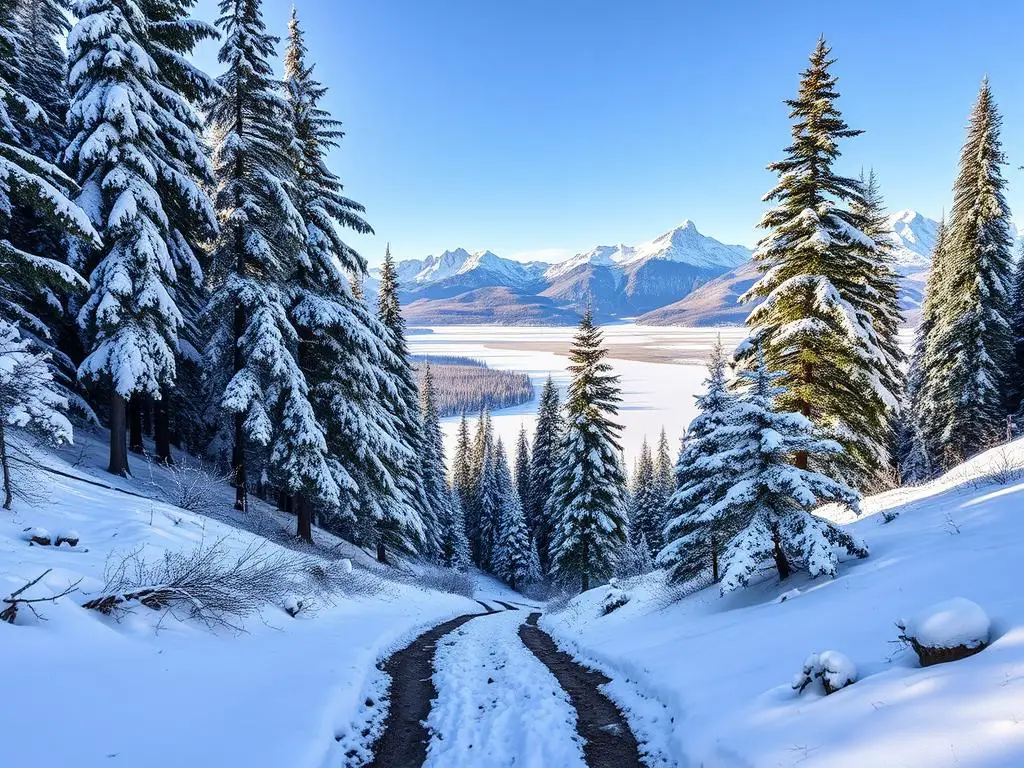As the cold air hits your face, you feel excited. The world turns into a sparkling wonderland, calling you to explore. Winter hiking spots have a special charm that summer trails can’t beat. The snow-covered trees and frozen waterfalls make the landscape a beautiful icy painting.
Imagine being on a mountain, your breath showing in the air, and seeing frosty peaks everywhere. This is the magic of hiking in the cold. It lets you see the world in a calm, icy sleep, ready to wake up with your steps.
Winter adventure travel is more than just beautiful views. It’s about testing yourself, finding your limits, and loving nature’s strength. Walking through snow or icy paths connects you deeply with nature, something summer hikes can’t offer.
The U.S. has many winter hiking spots, from Death Valley’s sunny trails to the Adirondacks’ snowy peaks. Many trails are open all year, needing only microspikes for icy parts. Whether you want a short hike or a long trip, there’s a great winter trail for you.
When planning your winter hikes, remember to prepare well. The right gear, knowing the terrain, and understanding safety are key. With good planning, you’ll discover a world of winter beauty that few see.
Key Takeaways
- Winter hiking offers unique landscapes with snow-dusted scenery and frozen formations
- Many U.S. trails are accessible year-round, often requiring only microspikes for icy conditions
- Proper preparation and safety knowledge are crucial for winter hiking adventures
- Winter trails range from easy loops to challenging multi-day treks
- Popular destinations include Death Valley, Colorado Springs, and the Adirondacks
- Winter hiking provides opportunities for solitude and unique wildlife encounters
Embracing the Magic of Winter Hiking
Winter turns familiar places into magical wonderlands. Snowy trails offer a special adventure for outdoor lovers. The cool air and quiet make it perfect for hiking in the snow.
Winter activities push your limits and keep you fit. Hiking all year keeps you ready for spring and summer. If you’re new, start with short walks and easy paths.
- Frozen waterfalls become intricate ice sculptures
- Snow-drifted trees create ethereal landscapes
- Alpine lakes turn into frozen jewels
- Wildlife tracks in snow tell silent stories
Winter trails are quiet and peaceful. This calm is great for thinking and connecting with nature. Seasoned hikers love this time, using special gear and checking the weather first.
But winter hiking has its own challenges. Be ready for cold weather and possible avalanches in mountains. With the right prep, you’ll find the beauty of winter trails and have amazing snow hikes.
Essential Gear for Winter Hiking Adventures
Winter hiking needs the right gear to stay safe and comfy. Start with a base layer of merino wool or synthetic fabric. This traps heat and wicks away moisture. Next, add a mid-layer of fleece or wool for extra warmth.
Finally, wear a waterproof, breathable outer shell. This protects you from wind and snow.
Footwear is key for winter hiking. Choose waterproof, insulated boots to keep your feet dry and warm. Wear wool socks, like Darn Tough Hiker Micro Crew Cushion, for the best comfort.
Don’t forget microspikes or crampons for icy trails. And snowshoes for deep snow.
Keep your hands and head warm with gloves, a beanie, and a neck gaiter. Outdoor Research Vigor Heavyweight Sensor Gloves are great for cold weather. For extra warmth, bring hand warmers and a lightweight down jacket, like the Arc’teryx Cerium Down Hoodie.
- Trekking poles with snow baskets for balance
- A larger backpack to carry extra gear
- Insulated water bottle and thermos for warm drinks
- Emergency supplies and navigation tools
Winter hiking needs more gear than summer hikes. Pack smart and wear layers to enjoy winter trails safely.
Safety Tips for Cold Weather Hiking
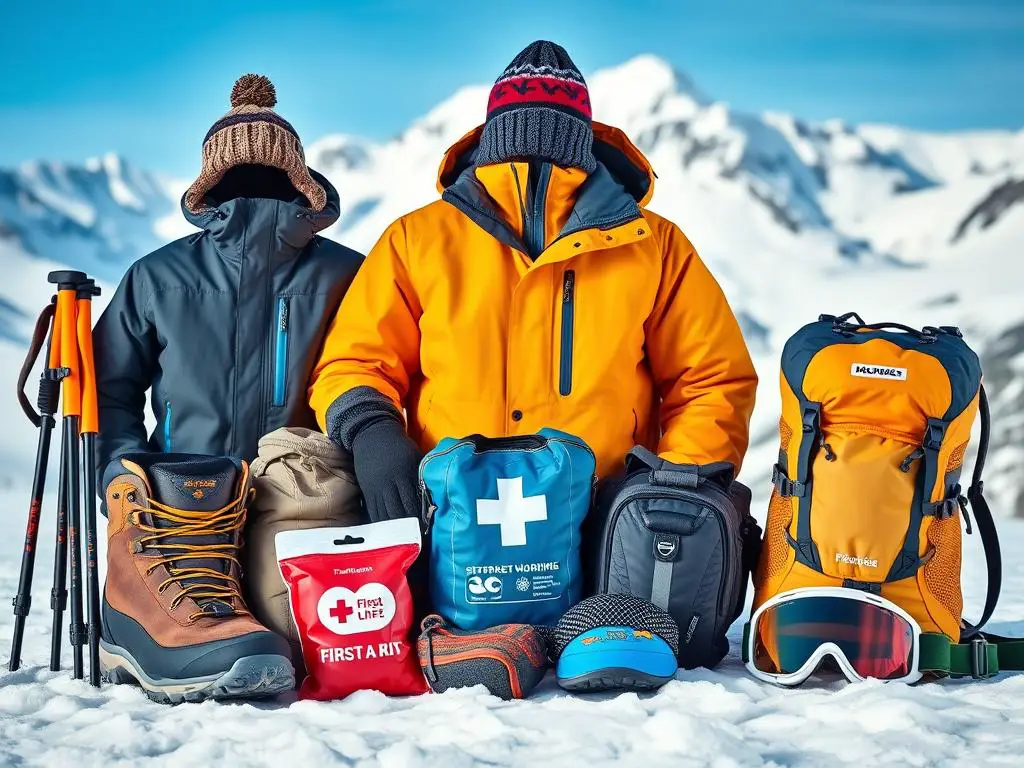
Winter hiking is stunning but comes with its own set of challenges. Your safety depends on being well-prepared and aware. Always check the weather and avalanche reports before you go. Also, let someone know where you’re going and when you’ll be back.
Dressing correctly is key for cold weather hiking. Wear layers and don’t forget a hat. Your head loses a lot of heat! Carry high-energy snacks and keep them warm. Also, bring lots of water and keep it close to your body to avoid it freezing.
Good footwear is essential for winter hiking. Get quality boots and traction devices like micro spikes for icy paths. Don’t forget trekking poles for better balance. Stay updated on trail conditions and be ready to head back if they’re too tough.
- Carry a first-aid kit and emergency shelter
- Bring a headlamp for shorter winter days
- Keep electronics warm in interior pockets
- Use UV-rated snow goggles or sunglasses
Winter hiking needs extra caution. Know the signs of hypothermia and frostbite. By following these tips, you’ll have a safe and fun winter hike.
Winter Hiking Destinations in the West
The western United States is full of amazing winter hiking spots. You can explore snow-covered mountains or sunny deserts. Death Valley National Park is especially great in the cooler months, with temperatures just right for hiking.
Colorado’s Steamboat Ski Resort sits at 9,080 feet and has incredible winter trails. The area around it is perfect for winter hikes, with Telluride getting 300 sunny days a year. It’s a great place for winter fun, with clean air and clear skies.
Sequoia National Park in California is another must-see. It’s home to the world’s biggest trees and looks magical in winter. The snow against the sequoias’ bright red bark is truly magical.
- Death Valley: Mild winter temperatures perfect for hiking
- Steamboat Springs: High-altitude trails with abundant sunshine
- Sequoia National Park: Snow-covered giants for a memorable hike
Winter hikes in the West vary a lot. Always check the trail and weather before you go. With the right prep, you’ll see the West’s winter beauty in all its glory.
Exploring Death Valley’s Golden Canyon in Winter
Winter turns Death Valley into a dream spot for hikers. From November to March, the Golden Canyon and Gower Gulch Loop are ideal for hiking. These trails offer stunning views without the summer heat.
The Golden Canyon Trail has three main paths for hikers:
- To Red Cathedral: 2.8 miles with 500 ft elevation gain (Easy)
- Zabriskie Point to Golden Canyon: 1.7 miles one-way with 650 ft elevation gain (Easy)
- Gower Gulch Loop: 4.5 miles with 850 ft elevation gain (Moderate)
As you walk these trails, you’ll see golden sandstone canyons and badlands. The winter weather is mild, with temperatures in the 60s and 80s in early November.
Make sure to bring what you need for your hike. Carry at least 2 liters of water per person for short hikes. Also, bring salty snacks, sunscreen, and a wide-brimmed hat. Trekking poles can help on rough terrain.
Death Valley’s winter trails offer a special hiking experience. You’ll see amazing desert views and interesting rock formations without the summer crowds. It’s a great place for those looking for adventure in a cooler climate.
Spectacular Winter Trails in Colorado
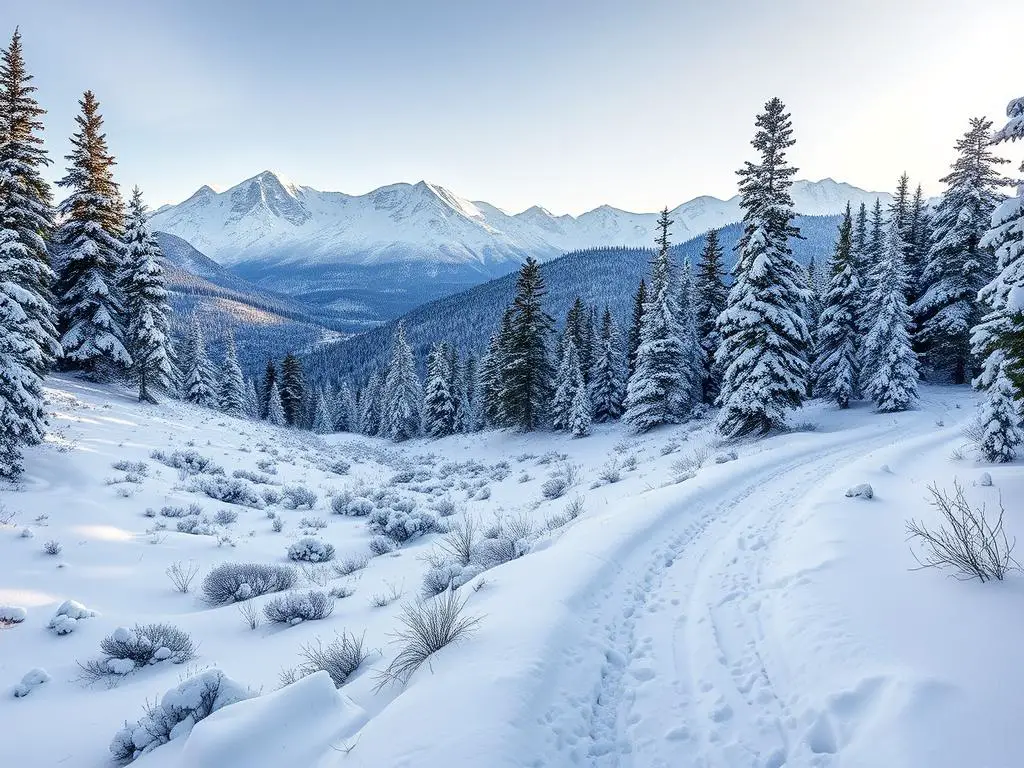
Colorado winter hiking is a breathtaking experience for outdoor lovers. The state has many Rocky Mountain winter trails for all hikers. You’ll see snow-covered meadows and icy glaciers, turning Colorado into a magical wonderland.
Garden of the Gods in Colorado Springs is a top spot for winter hiking. The Chambers/Bretag/Palmer Trail and Perkins Central Garden Trail offer stunning views. These paved paths are great for winter shoes, welcoming most visitors.
Steamboat Springs offers exciting adventures. It has a huge snowmobiling trail system that reaches the Continental Divide. You can go on guided tours or explore snowy meadows by yourself. Grand Lake is known as the “Snowmobiling Capital of Colorado,” with over 300 miles of trails, more than half groomed.
St. Mary’s Glacier in Idaho Springs is perfect for winter hiking. It offers Rocky Mountain views and a glacier-fed lake. Matthew/Winters Park in Golden is great for families, with a 4.5-mile loop trail and views of Red Rocks Park, just a short drive from Denver.
Always check trail conditions and pack the right gear for your Colorado winter hike. The Rocky Mountain winter trails promise unforgettable experiences, from calm snowshoe walks to thrilling snowmobile rides.
Winter Hiking in the Pacific Northwest
The Pacific Northwest is a paradise for winter hikers. Washington’s trails range from simple walks to tough hikes, fitting all skill levels. Forest Park’s Wildwood Trail is a 5.1-mile path through beautiful scenery, ideal for a cold winter day.
Looking for a longer hike? Try the Cape Horn Loop Trail in Washougal, Washington, which is 7.5 miles long. It’s great for dog owners and bird watchers. Dog Mountain in the Columbia River Gorge offers a 6-mile trail with a huge 2,800-foot climb.
Winter backpacking in the Pacific Northwest needs careful planning. Keep these tips in mind:
- Group size in Wilderness areas should not exceed 12 people
- Self-issued wilderness permits are necessary for overnight stays
- Winter safety precautions are crucial due to low temperatures and potential snow
For a milder hike, Tryon Creek State Natural Area in Southwest Portland is perfect. Its easy 2-mile trails take about an hour to complete. Whether you’re on a short hike or a long backpacking trip, the Pacific Northwest’s winter trails offer amazing adventures and stunning views.
California’s Sequoia National Park: A Winter Wonderland
Sequoia National Park turns into a magical winter wonderland. It offers amazing hiking experiences among snow-covered giant sequoias. With 37 inches of snow on average, it’s a perfect place for winter fun.
The Big Tree Trail is a great choice for winter hikes. It’s a 1.3-mile loop that’s easy for families. The trail has a raised boardwalk, making it safe to walk on in the snow. Microspikes are suggested for icy spots.
Winter in Sequoia National Park is cold, with temperatures from 36°F to 16°F. Dress warmly and wear layers. Besides hiking, you can also snowshoe and ski here.
Always check the road conditions and chain rules before you go. The speed limit is 25 mph when chains are needed. Some areas close in winter, but you can still see the Giant Forest Grove and General Sherman Tree.
Don’t miss the Tunnel Log, a fallen sequoia you can walk through. Near it, the Parker Group is a dense sequoia cluster named after James Parker. These sights make Sequoia National Park a must-see for winter adventures.
Winter Hiking Destinations in the Northeast
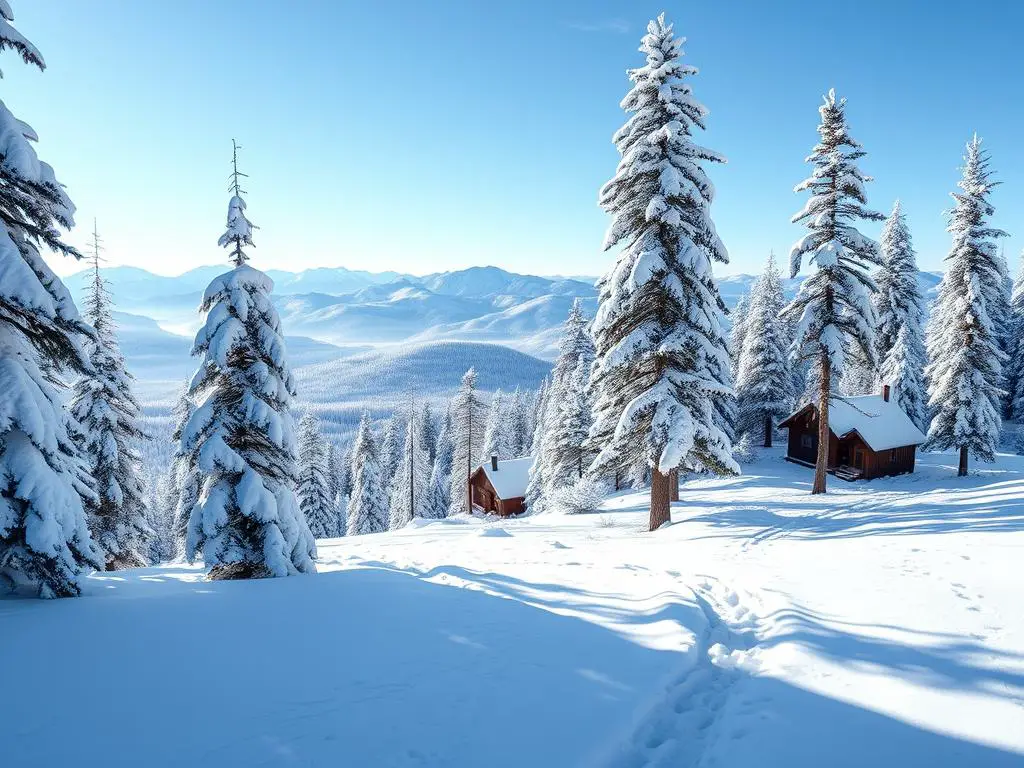
Northeast winter hiking is a thrilling adventure for outdoor lovers. The area has many trails that turn into magical winter scenes. These are ideal for those looking for a cold challenge. You’ll find everything from the rugged Adirondacks to New England’s scenic paths.
The Adirondacks in New York are known for their stunning winter views. Cascade Mountain, a 4.8-mile trail, offers amazing summit views. Mount Marcy, the highest peak in New York, is a more challenging climb at 5,344 feet.
New Hampshire’s White Mountains are a haven for winter hikers. Mount Washington, the tallest peak in the Northeast, has strong winds. The Franconia Ridge trail is a tough 8.3-mile loop with incredible views.
- Mount Monadnock in New Hampshire attracts over 100,000 hikers annually
- Acadia National Park features challenging ladder trails with iron rungs
- Cutler Coast in Maine offers 12,000 acres of well-marked coastal trails
For a milder hike, try Sabbaday Falls in New Hampshire. This 0.4-mile trail is easy for all levels, even wheelchair users. Don’t forget to dress warmly and pack the right gear for your winter hike. The Northeast’s trails offer unforgettable experiences for all outdoor fans.
Warm Winter Hikes in the Southwest
Escape the cold and enjoy warm winter trails in the Southwest. This area is great for hiking from November to March. Arizona, New Mexico, and California have mild weather and lots of sunshine, perfect for outdoor fun.
Joshua Tree National Park in California is a top spot for winter hikes. Daytime temperatures are in the 50s and 60s, making it easy to explore. The Mastodon Peak trail, a 2.4-mile loop, offers amazing views of the Salton Sea and Mojave Desert.
In Arizona, Sedona’s trails are less crowded in winter. The Cathedral Rock Trail and Bell Rock Loop show off stunning red rock views. White Sands National Park in New Mexico is also a must-see. Here, you can hike across beautiful dune fields in winter.
- Pack layers for changing temperatures
- Bring plenty of water, even in cooler weather
- Check park websites for current trail conditions
The Southwest’s warm winter trails offer amazing hiking experiences. From Tucson’s towering saguaros to Utah’s ancient canyons, there’s adventure waiting on these paths.
Read More-
Exploring Big Bend National Park in Winter
Winter turns Big Bend National Park into a dream destination for hikers. Temperatures range from the 60s to 30s, making trails perfect for exploring. With fewer visitors, it’s a quiet time for those who love peace and nature.
Big Bend offers trails for every hiker. The Santa Elena Canyon Trail is a 2-mile round trip with amazing Rio Grande views. For a bigger challenge, try the South Rim Loop. This 12-14.5 mile hike goes up 2,000 feet, offering stunning views at the top.
Winter at Big Bend offers special experiences:
- Stargazing in an International Dark Sky Park
- Exploring the Chisos Basin with fewer crowds
- Hiking the Lost Mine Trail for panoramic views
- Experiencing the Window Trail’s gentle descent to a dramatic canyon overlook
Don’t forget to bring layers for your hike. Even though it’s usually warm, it can get cold. With the right gear, you’ll enjoy Big Bend’s winter trails safely and comfortably.
Winter Hiking in Arizona’s Diverse Landscapes
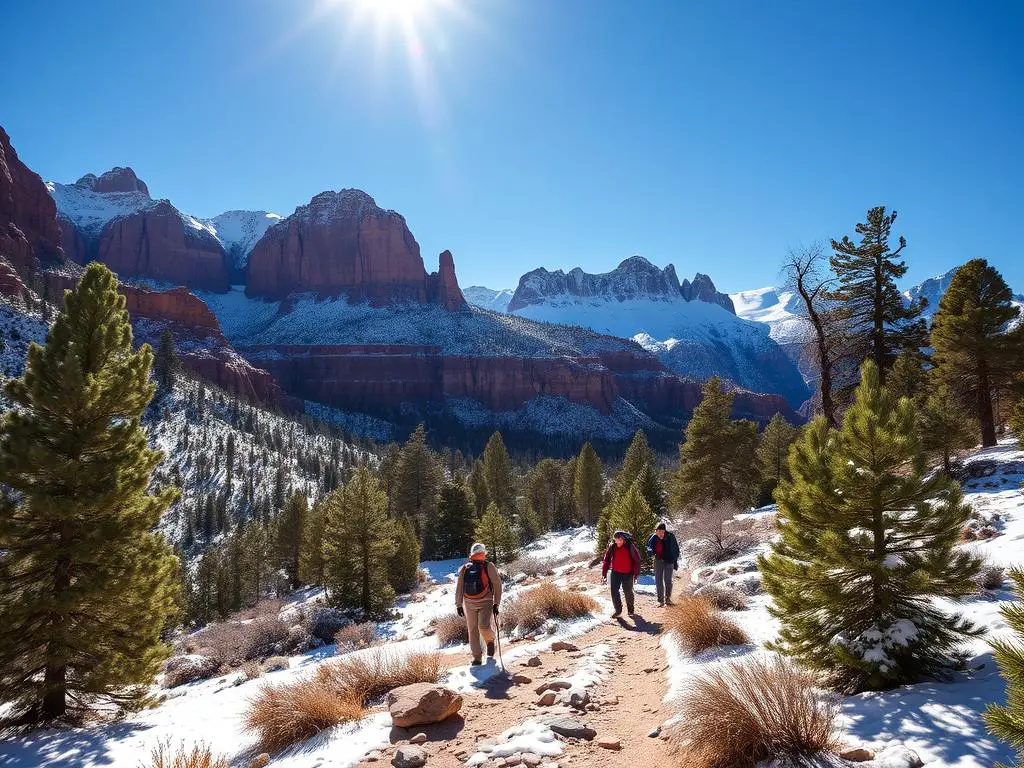
Arizona’s winter hikes are a mix of experiences. You can find snowy trails and warm desert paths. This makes for unforgettable adventures.
The Tom’s Thumb Trail in Scottsdale is a favorite. It’s a 4-mile moderate hike that might surprise you with snow at higher elevations. In Tucson, the Seven Falls Trail is easier to navigate in winter due to dry conditions.
For a challenge, try the Siphon Draw Trail to Flatiron. This 5.5-mile hike has steep ascents and can be snowy or icy. It’s a true test of your winter hiking skills.
- Massacre Falls Trail: 5.77 miles with 1,109 feet elevation gain
- Wave Cave Trail: 3.18 miles with 896 feet elevation gain
- Freedom Trail and Piestewa Peak: 4.8 miles with 1,748 feet elevation gain
- Fat Man’s Pass via Mormon Trail: 4 miles with 900 feet elevation gain
Did you know Arizona has more mountains than Switzerland? This means endless trails for your desert winter hiking adventures. South Mountain Park in Phoenix has a 14.3-mile National Trail, ideal for a full day of exploration.
Remember, Arizona’s winter temperatures can vary a lot. You might enjoy 80°F in Phoenix while Flagstaff is chilly at 30°F. Always check local conditions before heading out on your Arizona winter hikes.
New Zealand: A Southern Hemisphere Winter Hiking Paradise
Experience the enchantment of New Zealand’s winter hiking from June to August. This Southern Hemisphere gem is a treasure trove of natural wonders. You’ll see snow-covered peaks and enjoy trails with fewer people.
New Zealand’s winter trails are a haven for hikers. The country boasts 10 Great Walks, perfect for multi-day hikes. You can camp or stay in huts along the way. But, remember to book early as these spots get filled fast.
When you explore New Zealand’s winter landscapes, safety comes first. Mountain huts offer weather forecasts twice a day. These shelters are vital, as strong winds can destroy tents in open areas. Be ready for stream crossings, steep paths, and alpine walks.
- Best hiking season: October to April
- Ideal months: November and December
- Average accommodation cost: $50 per night
- Car rental for a month: Around $816
For a memorable trip, look out for the world’s largest buttercup and Mt. Cook lilies on trails. Also, watch your belongings around playful kea parrots at campsites. New Zealand’s winter hiking offers unforgettable journeys through stunning landscapes.
Winter Hiking Destinations in Europe
Europe is a paradise for winter hiking. You can explore snowy mountains or coastal paths. Spain’s Canary Islands offer mild weather and beautiful views. El Hierro, a hidden gem, has 23 top-rated hiking tours.
Tenerife is known as a “Walking Paradise” with 15 great reviews. Its trails are a must-see for any hiker.
Slovenia is a unique winter hiking spot. The Lake Bohinj hike is a 12 km loop that takes 3-4 hours. It’s best to wear waterproof boots, especially when the lake is icy.
In Switzerland, the Val Lumnezia hike is a 7.5 km trail covered in snow from December to March. It’s an easy 2-3 hour walk with a 255 meter elevation gain.
Bulgaria’s Rila mountains offer a challenge. The Seven Lakes and Ivan Vazov Hut hike is a 4-5 hour circular walk. The lakes are between 2,000 and 2,500 meters high, offering stunning winter views.
For an iconic English winter hike, try Helvellyn in the Lake District. It’s a detailed experience with snow and ice.
- El Hierro, Spain: 23 highly-rated hiking tours
- Lake Bohinj, Slovenia: 12 km circular hike
- Val Lumnezia, Switzerland: 7.5 km snow-covered trail
- Rila Mountains, Bulgaria: Seven Lakes circular walk
- Helvellyn, England: Iconic winter hiking experience
Conclusion
Winter hiking opens up a world of outdoor adventures. It offers unique experiences and breathtaking views. You’ll find quieter trails, especially mid-week, for peaceful exploration.
The snow-covered landscapes provide forgiving terrain. This makes it easier to venture off-trail and discover hidden gems.
As you embark on winter hiking trips, you’ll be rewarded with spectacular vistas. You’ll see snowy peaks, frozen lakes, and ice formations. The reduced human activity increases your chances of wildlife encounters, adding an exciting element to your journey.
The absence of pesky bugs enhances your hiking experience. Remember, winter hiking comes with its own set of challenges. You’ll need to adapt your clothing, manage moisture, and carry extra gear.
The shorter daylight hours mean packing a headlamp is crucial. While your pace may be slower, the sense of accomplishment at the end of a winter hike is unmatched.
Whether you’re crossing snow-covered bridges, spotting chamois in alpine regions, or marveling at frozen waterfalls, winter hiking offers unforgettable memories. With proper planning, the right gear, and respect for nature, you can safely enjoy the magic of winter trails. So gear up, step out, and embrace the wonder of winter hiking adventures!
FAQ
What are the benefits of winter hiking?
Winter hiking brings unique experiences. You’ll see snow-dusted trees and frosted leaves. The low, moody sunlight adds magic to familiar landscapes.
It also keeps you fit for spring and summer adventures.
What are some potential challenges of winter hiking?
Winter hiking can be risky. There’s danger from avalanches in mountains and harsh weather. But, with the right prep and knowledge, you can stay safe.
What essential gear is needed for winter hiking?
For winter hiking, you need warm, layered clothes. Insulated, waterproof boots are a must. Microspikes or crampons help with icy paths.
Snowshoes are needed for deep snow. A waterproof jacket and thermal layers keep you warm. Don’t forget a warm hat, gloves, and trekking poles.
Carry extra food, water, and emergency supplies too.
What safety precautions should be taken for winter hiking?
Always check the weather and avalanche reports. Tell someone your hiking plans. Stay hydrated and know the signs of hypothermia and frostbite.
Be ready to turn back if it gets too bad. Carry a first-aid kit and emergency shelter.
What are some popular winter hiking destinations in the western United States?
Western destinations like Death Valley National Park and Big Sky in Montana are popular. Garden of the Gods in Colorado Springs is another favorite. They offer different landscapes, from deserts to snow-covered mountains.
What are some recommended winter hikes in the Pacific Northwest?
In the Pacific Northwest, try the Baker Lake Trail in Washington’s North Cascades. The Big Tree Trail in Sequoia National Park is also great for winter hiking.
Where can you find challenging winter hiking experiences in the Northeast?
The Northeast has tough hikes. Try the Billy Goat Trail in Maryland, Cascade Mountain in the Adirondacks, and Franconia Ridge in New Hampshire.
What are some warm winter hiking options in the Southwest?
In the Southwest, Mastodon Peak in Joshua Tree National Park is a warm spot. The Santa Elena Canyon Trail in Big Bend National Park is another choice. Arizona has many trails for warm winter hikes.
Are there any notable winter hiking destinations in the Southern Hemisphere?
New Zealand is a top spot for winter hiking in the Southern Hemisphere. It has majestic mountains, pristine lakes, lush forests, and scenic coastlines.
